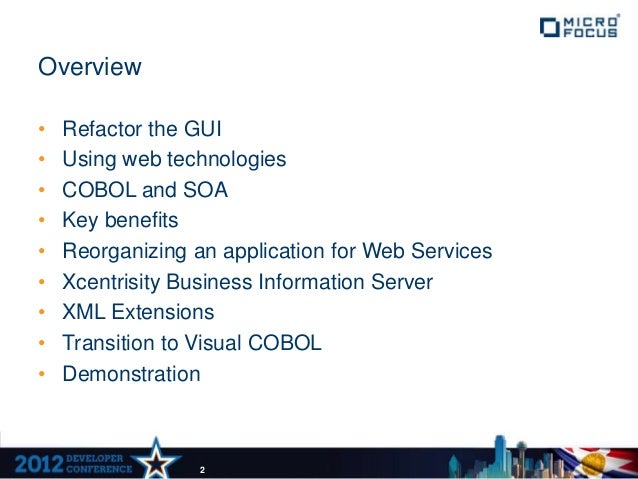Microfocus Cobol Tutorial Pdf

Contents ALM 1 WelcometothisTutorial 6 HowThisTutorialisOrganized 6 BeforeYouBegin 7 Chapter1:IntroducingALM 9 TheALMProcess 10 StartingALM 10 ALMWindow 11. 6 Brochure Visual COBOL from existing COBOL applications. Once cre-ated, services can be debugged and deployed within the Micro Focus COBOL Server for SOA.
PDF documents may be created using XML Extensions in conjunction with the open source Apache FOP product for a cost effective solution.
Problem:
Modern applications are often required to produce PDF documents, for example as replacements for traditional printed reports or as a standardized mechanism to distribute documents via email. Many of the available existing PDF creation solutions are expensive and/or lack the portability of RM/COBOL applications.
Micro Focus Cobol Tutorial
Resolution:
Apache FOP (Formatting Objects Processor) is a print formatter driven by XSL formatting objects (XSL-FO) and an output independent formatter. Because it is a Java application, its portability is quite comparable to an application implemented in RM/COBOL or Xcentrisity Business Information Server. Apache FOP is an open source project of The Apache Software Foundation licensed under the terms of the Apache License, Version 2.0, which permits redistribution under terms that are quite useful for an application developer. Binary distributions of Apache FOP are available for many popular platforms.
XSL Formatting Objects (XSL-FO) is a standardized, XML-based technology for describing output documents. As such, it is an excellent fit for use with XML Extensions.
The attached sample provides a simple illustration of the power of XSL-FO. The RM/COBOL program creates an XML document containing the data to be used to address an envelope, and then uses CALL “SYSTEM” to invoke the Apache FOP processor. Note that this sample program was created on Windows, and the Apache FOP processor binary distribution is assumed to be installed in C:FOP. To use this example on Linux or UNIX, the CALL “SYSTEM” statement must be changed to reflect (1) the differences in CALL “SYSTEM” between Windows and Linux/UNIX, and (2) the differences in installation of the Apache FOP binary distribution.
Micro Focus Cobol Tutorial
The sample data is exported from the COBOL program to envelope.xml. The Apache FOP process uses envelope.xml as its input document, transforming the input document using the XSL style sheet envelope.xsl, to produce the resulting PDF document, envelope.pdf. The XSL style sheet imports two other XSL style sheets, postnet.xsl and postnet-svg.xsl, which are used to created the POSTNET barcode (using SVG graphics) for the addressee. The XSL style sheet also uses the JPEG file, MicroFocusLogo.jpgDownload furry doll maker male sonic games. , to illustrate the ability to include graphical elements in the output document.
Several commercial products are available to assist in the creation of an XSL style sheet to convert the data from XML to XSL-FO (envelope.xsl in the example). Enter the search term “XSL-FO WYSIWYG” in a search engine to find several. An XSL style sheet is a text document, so a text editor may be used to modify existing XSL style sheets, or to create style sheets for simple documents.
The sample program was tested using the current version of Apache FOP, version 0.95. This version seems quite capable, and should work for most requirements. Commercial FOP rendering engines also exist, and may be more appropriate for high volume commercial applications; use the search term “XSL-FO rendering engine” to find several.

Wikipedia has an excellent article on XSL Formatting Objects which can be used as a starting point for finding reference material and tutorials on XSL-FO.